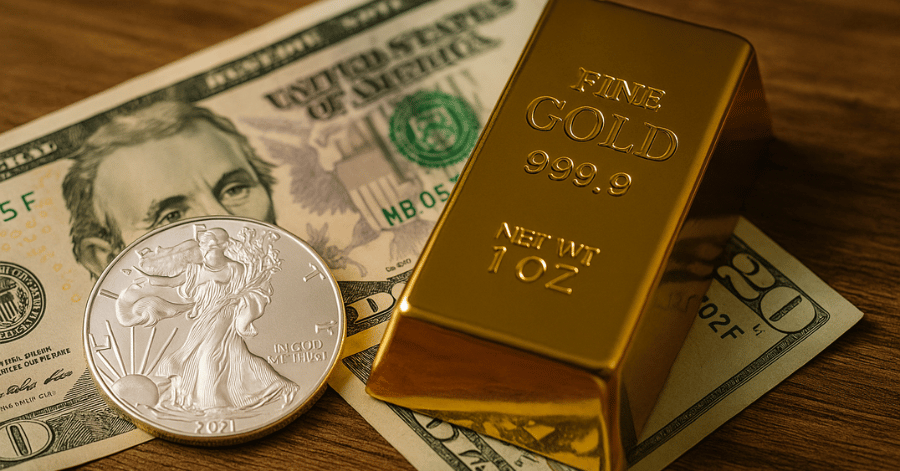A 2025 Investor’s Guide to Karats, Fineness, and Value
Key Takeaways: Gold Purity Essentials
🔬 Two Purity Systems to Know
• Karat system: Used for jewelry (24K = pure gold) • Fineness system: Used for investment bullion (.999 = 99.9% pure) • Fineness is what matters for serious investors
📊 IRA Gold Requirements
• Minimum .995 fineness required for IRA eligibility • Exception: American Gold Eagles (.9167 fineness) are IRA-approved • Work with reputable dealers who guarantee IRA compliance
💰 Purity Affects Price & Value
• Higher purity = closer tracking to spot price • .9999 fine may cost more than .999 fine (more refining needed) • LBMA-approved products offer maximum global liquidity
⚖️ Investment vs. Jewelry Gold
• Investment grade: .995+ fineness bullion • Jewelry alloys: Yellow, white, rose gold (not IRA-eligible) • 24K gold too soft for jewelry, perfect for investment
🎯 Why Purity Matters in 2025
• “Rio Reset” economy demands authentic safe-haven assets • Diluted alloys don’t provide same wealth protection • Authenticity guarantees essential from trusted dealers
🔍 Bottom Line
• Know the fineness number before buying • Verify IRA eligibility for retirement accounts • Choose recognized standards for maximum liquidity • Partner with reputable dealers who guarantee purity
Why Gold Bullion Purity is Critical for Investors in 2025
To begin, in an economic landscape defined by the  ‘Rio Reset‘. A period of persistent inflation and a strategic shift away from the U.S. dollar. Investors are turning to gold for its proven ability to preserve wealth. However, the protection that gold offers is directly tied to its purity.
‘Rio Reset‘. A period of persistent inflation and a strategic shift away from the U.S. dollar. Investors are turning to gold for its proven ability to preserve wealth. However, the protection that gold offers is directly tied to its purity.
If you are buying gold as a safe-haven asset, you must be certain that you are acquiring investment-grade bullion, not a diluted alloy. Understanding the language of gold purity is the first and most critical step in safeguarding your investment. This guide provides a clear, authoritative explanation of gold purity standards to empower you to make informed decisions.
The Language of Purity: Karats vs. Fineness
First, it is essential to understand the two systems used to measure gold bullion purity. While they measure the same thing, they are used in different contexts.
- The Karat System (K): This system is most commonly associated with jewelry. It measures purity on a scale of 24 parts. Pure gold is 24 karats (24K). An 18K gold ring, for example, is 18 parts gold and 6 parts other metals. Making it 75% pure (18 ÷ 24).
- The Fineness System: This is the standard for investment-grade bullion. It measures purity in parts per thousand. A gold bar stamped with “.999” is 999 parts gold out of 1,000, or 99.9% pure. The highest purity commonly available, often called “four nines fine,” is .9999 or 99.99% pure.
For an investor, the fineness system is the most important metric to understand.
Interactive Tool: Gold Purity Standards & Conversion
To make these concepts tangible, this tool provides a clear comparison of purity standards and a simple conversion calculator.
The Investor’s Standard: Purity Requirements for Gold IRAs
For investors looking to use a self-directed IRA to hold physical gold, understanding purity is not just important—it’s mandatory. The IRS has strict rules about the types of precious metals that are eligible to be held in a Gold IRA.
As stated in the tool above. The IRS requires that gold bullion coins or bars meet a minimum fineness of .995. This ensures that the account holds investment-grade assets, not numismatic collectibles or jewelry. The one major exception to this rule is the American Gold Eagle coin. Though it is minted at 22K (.9167 fineness) for durability, Congress made it legally permissible for IRA inclusion.
This is where a reputable dealer becomes essential. A trusted specialist, like the experts at Birch Gold Group, will only source IRA-eligible bullion. Ensure that every product you purchase for your retirement account meets these strict government standards.

Affiliate Disclosure: To support our mission of providing valuable financial analysis, this page may contain affiliate links. If you follow a link and make a purchase, we may earn a commission at no additional cost to you. We only recommend partners we thoroughly research and trust.
How Purity Affects Value and Premiums
Generally, the higher the purity of a gold product, the more closely its price will track the spot price of gold. However, investors will also encounter premiums. A premium is the amount charged over the spot price. To cover the costs of fabrication, distribution, and a small dealer profit.
- Higher Purity Can Mean Higher Premiums: A .9999 fine gold coin may carry a slightly higher premium than a .999 fine coin of the same weight, reflecting the more intensive refining process.
- Liquidity: Bullion products that meet internationally recognized standards, like those from the London Bullion Market Association (LBMA), are highly liquid and easily traded worldwide. Their purity is trusted globally.
Read Our Article About Gold Bullion Premiums

A Note on Gold Alloys
While investment bullion is defined by its high purity, most of the gold encountered in daily life is an alloy. An alloy is a mixture of gold with other metals, like copper, silver, or nickel. This is done primarily to increase durability, as 24K gold is too soft for most jewelry.

- Yellow Gold: Gold + Silver + Copper
- White Gold: Gold + Palladium or Nickel
- Rose Gold: Gold + Copper
While beautiful, these alloys do not meet the purity requirements for investment in a Gold IRA and should be considered jewelry, not investment assets.
Frequently Asked Questions (FAQ)
Q: What’s the difference between 24K and .999 fine gold? A: They’re essentially the same purity level but measured differently. 24K uses the karat system (24 parts), while .999 uses fineness (999 parts per 1,000). Both represent 99.9% pure gold, which is investment-grade bullion.
Q: Why are American Gold Eagles IRA-eligible if they’re only 22K (.9167 fine)?
A: Congress specifically exempted American Gold Eagles from the standard .995 fineness requirement. This exception was made because Eagles are legal tender coins minted by the U.S. government, even though they contain 91.67% gold plus silver and copper for durability.
Q: Can I use 18K gold jewelry in my Gold IRA?
A: No. 18K gold (.750 fine) doesn’t meet the IRS minimum requirement of .995 fineness. Only investment-grade bullion coins and bars are eligible for Gold IRAs, not jewelry or collectibles.
Q: How can I verify the purity of gold I’m buying?
A: Reputable dealers provide certificates of authenticity and purity assays. Look for hallmarks, buy from established dealers, and consider third-party testing if purchasing large quantities. Avoid deals that seem too good to be true.
Q: What’s a typical premium over spot price?
A: Premiums vary by product type: Gold bars (1-3%), popular coins like Maples or Eagles (3-6%), rare or collectible coins (10%+). Higher premiums don’t always mean better investment value.
Q: Is .9999 fine gold better than .999 fine for investment?
A: Both are excellent for investment purposes. The difference (.01%) is minimal. .9999 fine may carry slightly higher premiums due to more intensive refining, but both track spot gold prices closely and are highly liquid.
Q: Can gold purity change over time?
A: No. Pure gold doesn’t tarnish or degrade. However, gold-plated or filled items can wear off, and alloys can tarnish. Investment-grade bullion maintains its purity indefinitely when properly stored.
Q: What happens if I accidentally buy non-IRA eligible gold for my retirement account?
A: The IRS considers this a prohibited transaction, potentially resulting in taxes and penalties. Work with qualified custodians and dealers who specialize in IRA-eligible precious metals to avoid this issue.
Q: Are foreign mint coins like Canadian Maples IRA-eligible?
A: Yes, many foreign government-minted coins meet IRA requirements if they have .995+ fineness. Popular options include Canadian Maple Leafs, Austrian Philharmonics, and Australian Kangaroos.
Q: Should I buy the highest purity gold available?
A: Not necessarily. .999 fine gold offers excellent purity at competitive premiums. .9999 fine gold costs more but doesn’t provide significantly better investment characteristics. Focus on reputable sources and fair pricing over maximum purity.
Q: How much gold should I allocate to my investment portfolio?
A: This depends on your individual financial situation, risk tolerance, and investment goals. Many financial advisors suggest 5-10% of a portfolio in precious metals, but consult with a qualified financial advisor for personalized guidance.
Q: Can I store IRA gold at home?
A: No. IRS rules require IRA-held precious metals to be stored with an approved custodian or depository. Home storage disqualifies the metals from IRA treatment and may trigger taxes and penalties.
Conclusion: Purity is the Bedrock of Your Gold Investment
In closing, understanding gold bullion purity is not an academic exercise; it is a fundamental requirement for any serious investor. In the economic climate of 2025, when the primary goal of a gold allocation is security, you must have absolute confidence in the quality of the asset you are buying.
By mastering the language of karats and fineness, adhering to the strict IRS standards for retirement accounts, and partnering with a trusted dealer who can guarantee the authenticity of your bullion, you ensure that your investment is sound. This knowledge is the bedrock upon which a truly secure and resilient portfolio is built.








6 Comments